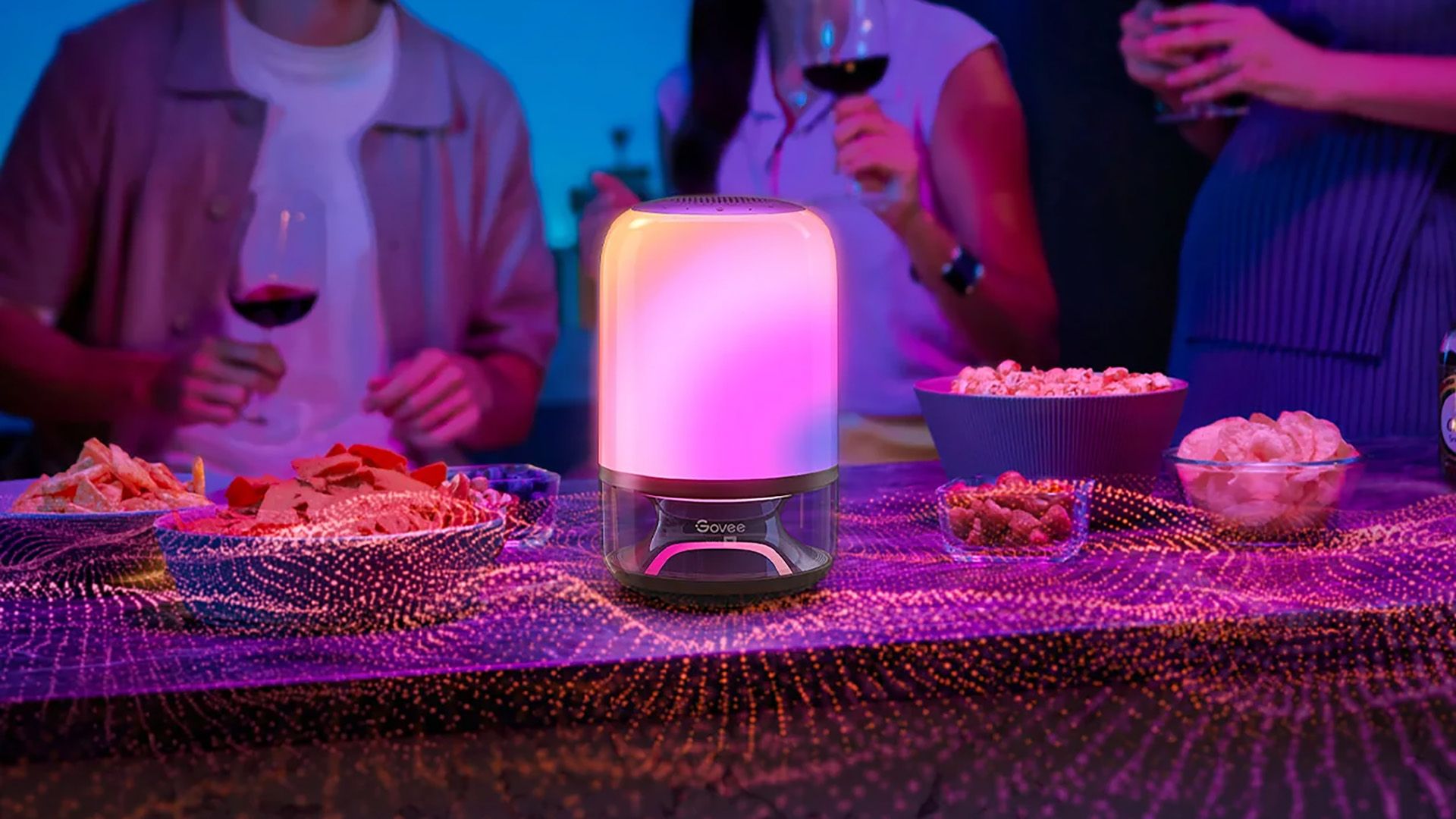XFX Mercury Radeon RX 9070XT OC Magnetic Air Edition with RGB review

When I heard that the new XFX Mercury Radeon RX 9070XT OC Magnetic Air Edition with RGB GPU has magnetic fans, I raised my eyebrows, but at the same time, I immediately wanted to test it. And, surprise, surprise: it’s not just marketing.🙂 The XFX Mercury is an overclocked monster, built on AMD’s RDNA 4 architecture. It has RGB lighting, stays cool and quiet thanks to a massive vapor chamber, and the fans can be easily detached for cleaning. More importantly, it’s one of the fastest Radeon RX 9070 XT implementations I’ve tested. It’s big, imposing, and pricey. But for gamers who want maximum performance in 1440p and 4K resolutions, along with a striking design, this card delivers it all. Here’s why:
XFX Mercury AMD Radeon RX 9070XT OC Magnetic Air Edition with RGB: Who is it good for?
This graphics card is a good choice for gamers and enthusiasts who want:
- Performance in 1440p or 4K resolutions, at Ultra graphics quality settings
- Efficient cooling, good airflow, and easy maintenance
- Excellent build quality
Pros and cons
Here’s what I liked about this graphics card:
- Great gaming performance in 1440p and 4K resolutions
- The Magnetic Air fans are easy to remove and clean
- The vapor chamber helps keep temperatures low
- It runs almost completely silently
- 16 GB of GDDR6 memory and improved ray tracing over the previous generation
- Beautiful lighting and a sleek design
And here’s what could be better:
- High power usage, around 340 watts
- It’s big and heavy, taking up four slots in your PC case
- High price, above AMD’s official recommendation
- It lags behind the NVIDIA GeForce RTX 5070 Ti in games with a lot of ray tracing

Verdict
The XFX Mercury RX 9070XT OC Magnetic Air is a powerful graphics card. It’s one of the fastest implementations of the Radeon RX 9070 XT, with the highest factory clock in its range. In benchmarks, it consistently outperforms other models and even rivals the GeForce RTX 5070 Ti in many games. Furthermore, it stays cool and quiet. The magnetic fans aren’t just a marketing gimmick, they actually do their job of making cleaning simpler and more efficient. Yes, this card draws a lot of electricity and has a steep price tag, but it offers top-notch 4K performance, excellent cooling, and a solid build. In short, if you want a beautiful and powerful video card, the XFX Mercury AMD Radeon RX 9070XT OC Magnetic Air Edition with RGB shouldn’t be ignored.
Unboxing the XFX Mercury AMD Radeon RX 9070XT OC Magnetic Air Edition with RGB
The card comes in a large, sleek box, with an impressive look. The front of the box displays a sketch of the video card, while the back highlights key features like the Magnetic Air system and the oversized heat spreader.
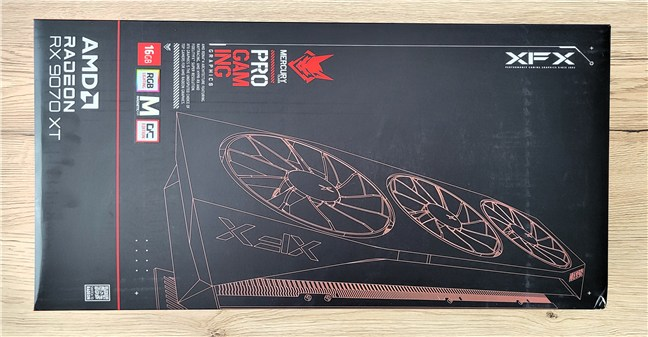

On the front, there’s a stylish sketch of the GPU
Inside, everything is well protected with lots of foam material. On top of the box’s entire contents, you find a clear instruction sheet with the fan positioning and a few QR codes for drivers, manuals, and the warranty card. The video card is packed separately, and the three magnetic fans are each placed in their own separate box. The package also includes a sturdy metal stand and an ARGB cable for synchronizing the lighting effects.
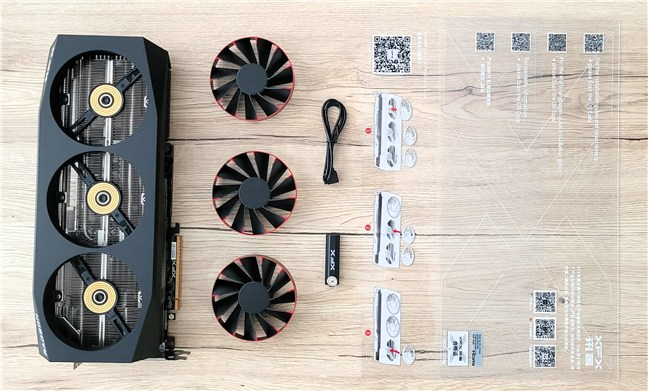

Inside the box, the GPU is kept separate from the fans
Unboxing this video card makes you want to set it up right away. And yes, it really does have magnetic fans.🙂
NOTĂ: We received this GPU through ASBIS, an European retailer of PC hardware. XFX products can be purchased from them and their partners. You can find more information about XFX here.
Design and hardware specifications
The XFX Mercury RX 9070XT OC Magnetic Air is built on AMD’s RDNA 4 architecture and uses the Navi 48 chip with 64 Compute Units and 4096 stream processors. It also includes the latest generation of Ray Accelerators, which improve ray tracing performance over previous AMD Radeon cards. The model includes 16 GB of GDDR6 memory on a 256-bit bus, running at 20 Gbps for a total bandwidth of 640 GB/s. Additionally, it has 64 MB of Infinity Cache, which contributes to more efficient memory performance, especially in 4K gaming.
XFX has factory overclocked this video card more than any other similar model I’ve seen so far. The boost clock can reach around 3100 MHz out of the box, higher than the GIGABYTE Radeon RX 9070 XT GAMING OC 16G (with a 3060 MHz boost clock) or the ASUS PRIME Radeon RX 9070 XT OC Edition (with a 3010 MHz boost clock).
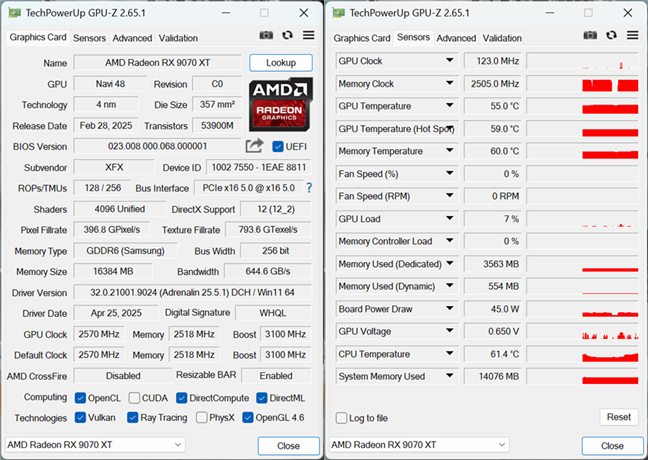

The GPU is overclocked out of the box
Physically, this video card is huge. It’s thick enough to take up 3.5 slots, which makes it block four slots inside the case. At about 14 inches (36 centimeters) long and 2.8 inches (7.2 centimeters) tall, it’s noticeably larger than the GIGABYTE and ASUS versions of the Radeon RX 9070 XT. It weighs around 3.75 pounds (1.7 kilograms), so the included stand isn’t just there for the visuals, it can actually be quite useful. The design is clean: a matte black metal plate on top, black plastic underneath. It also features discreet red accents around each fan and on the top edge, to match AMD’s “Red Team” visual identity.
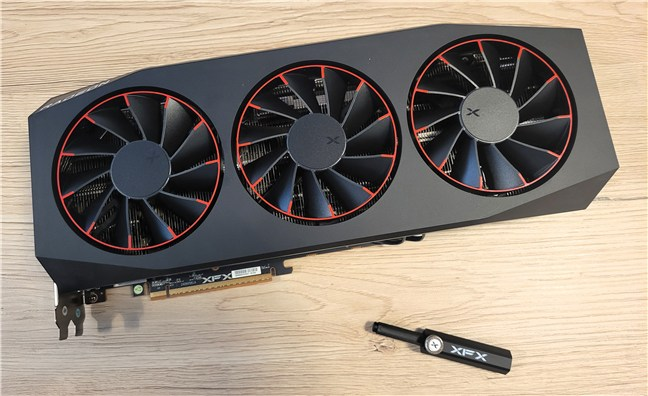

The GPU is in line with Red Team’s visual identity
As I was saying, on the top, there’s a metal backplate across the entire card to help with rigidity. A large cutout at the end allows air to flow better through the radiator fins. Despite its size, the overall design is balanced, and the card feels well built.
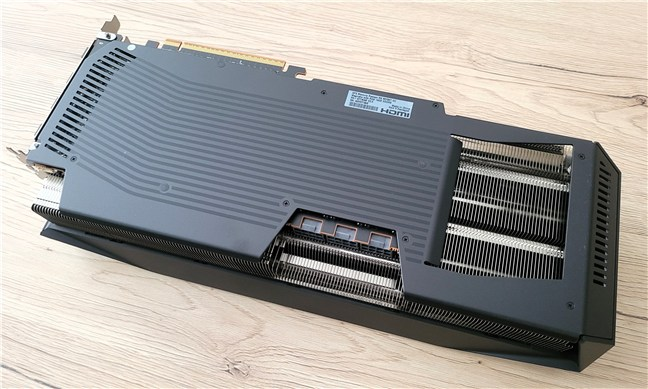

On the top, the card is protected by a black metal backplate
On the edge, this graphics card features a thin ARGB stripe, framed by backlit Radeon and XFX logos at both ends. The lighting can be synchronized with the rest of the system using the included cable, or you can turn it off completely for a simpler, more discreet look.
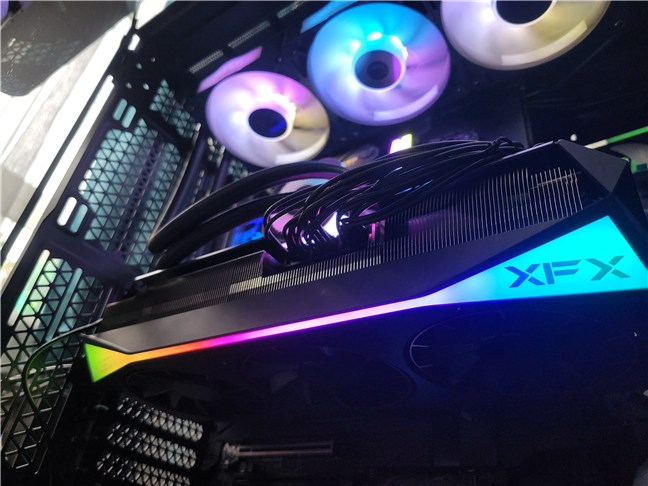

The GPU features RGB lighting on the edge
The cooling system is where Mercury raises the bar. At the base is a nickel-plated copper vapor chamber, along with 6mm copper heatpipes and a tall aluminum heat spreader. On top, sit three 100mm fans, but they’re not already installed, as we’re probably all used to.
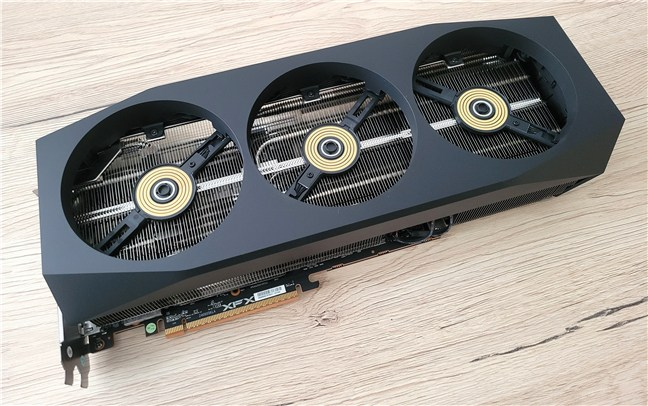

The fans are magnetic and can be easily removed
The fans use the XFX Magnetic Air system, allowing you to attach them without screws or cables. You pull them out easily and snap them back in.
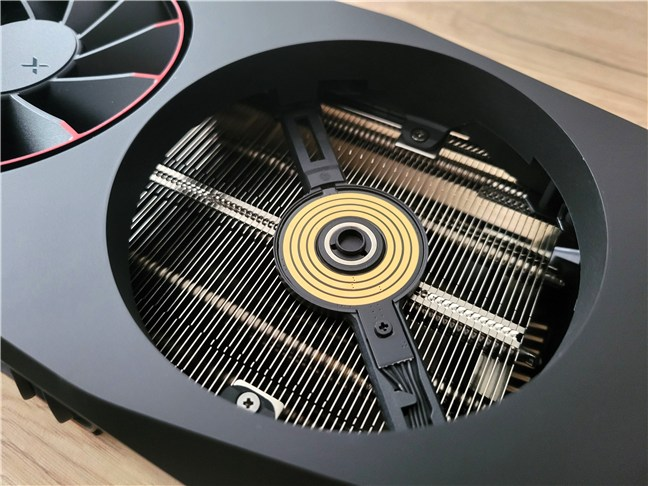

What the magnetic axis of the fan looks like
The magnetic connection is solid and instantly transmits power and PWM (Pulse-Width Modulation, precisely controls fan speed) signals. It is a fast, reliable system that makes cleaning or changing fans much simpler than traditional systems. The fans use double ball bearings, which should make them more robust.
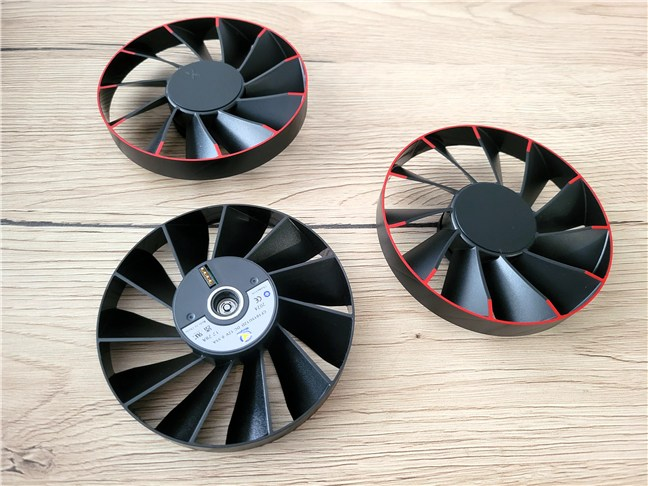

This is what the fans look like
The power supply is exactly what you’d expect from a card in this category. It requires three 8-pin PCIe connectors, and XFX recommends an 800W power source. The power supply ports are built into the end of the card, which helps with cable management in narrower cases.
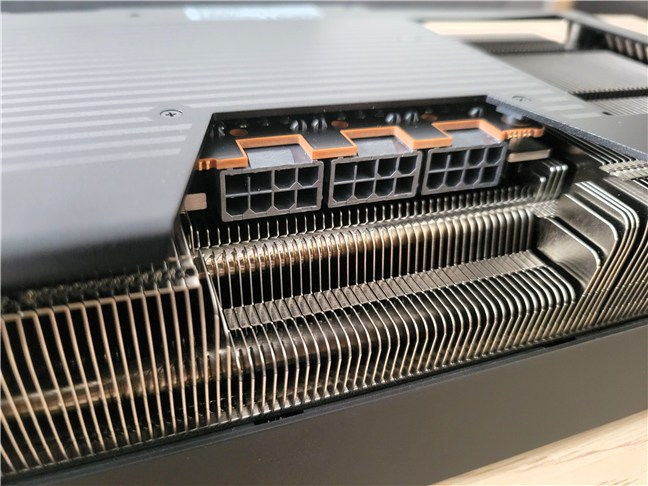

The GPU needs three power connectors
When it comes to video output, you get three DisplayPort 2.1a ports and one HDMI 2.1 port, all supporting resolutions up to 4K, ideal for monitors or high-end TVs.


You get three DisplayPort and one HDMI port
Last but not least, the video card also has a dual BIOS switch on the top edge. It allows you to choose between the two BIOSes of the card, but as far as I noticed, they are identical. There’s no switch to toggle between performance mode and a silent profile.


The BIOS switch and the ARGB cable jack
If you want even more details about the technical specifications of this video card, you can find them on its official page: XFX Mercury AMD Radeon RX 9070XT OC Magnetic Air Edition with RGB.
Overall, the XFX Mercury AMD Radeon RX 9070XT OC Magnetic Air Edition with RGB seems to be nothing short of a monster. It’s overclocked from the get-go, with a magnetic fan system and a huge cooling solution. Everything is built to squeeze the maximum performance possible out of the Radeon RX 9070 XT graphics chip, while also offering cool temperatures, low noise, and simple maintenance.
Using the XFX Mercury AMD Radeon RX 9070XT OC Magnetic Air Edition with RGB
Before we move on to benchmarks, I wanted to see how the XFX Mercury RX 9070XT OC Magnetic Air Edition performs in everyday use. Not just in synthetic tests, but in real gaming scenarios and regular computer usage. I installed it in a high-end PC, built expressly to showcase components of this caliber.
The test system used for this GPU
For this review, I used this gaming PC that I assembled and discussed in detail on Digital Citizen, with one change: the processor. Instead of the AMD Ryzen 7 9800X3D, which I no longer have, I used an AMD Ryzen 9 9900X. It’s a 12-core, 24-thread processor that won’t cause bottlenecks when testing GPUs, including high-end ones like the XFX Mercury AMD Radeon RX 9070XT OC Magnetic Air Edition with RGB.
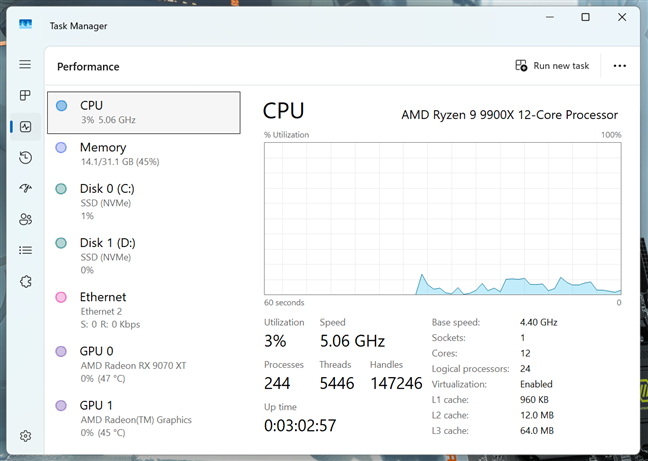

The CPU I used for the test PC
The rest of the setup stayed exactly the same:


A look at the test system
This setup gave the GPU full freedom to run at optimal parameters and maximum capacity.
Setup, daily use, and gaming experience
Setting up the XFX Mercury Radeon RX 9070XT GPU is simple, as long as you have enough room in the case. It effectively takes up four slots, so it doesn’t hurt checking the available space beforehand. When you get it installed, it sits nicely in place with no bending, a sign that its backplate and build are solid. As I pointed out earlier in this review, XFX also includes a metal stand for this backplate, but it wasn’t tall enough to use inside this computer case.
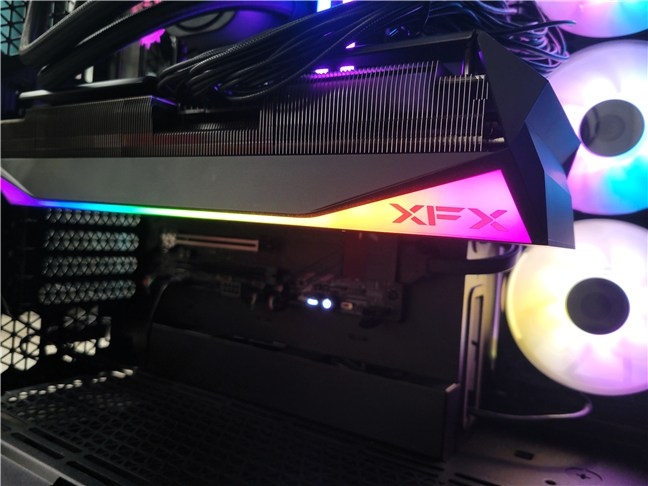

The GPU is big and bulky
I used the XFX Mercury Radeon RX 9070XT OC for a couple of days, both for everyday things like surfing the web and multimedia content, and for gaming. The drivers’ stability was impeccable. With the latest AMD Adrenalin version, I experienced no crashes, stutter, or any other strange behavior or errors. The gaming performance was excellent. I tested Star Wars Outlaws and Indiana Jones and the Great Circle, both at 4K resolution, with Ultra graphics settings and ray tracing enabled, as well as with AMD FSR (Quality mode) and Frame Generation enabled. The frame rates were very good (over 60 fps) in both Star Wars Outlaws and Indiana Jones, delivering an excellent gaming experience.
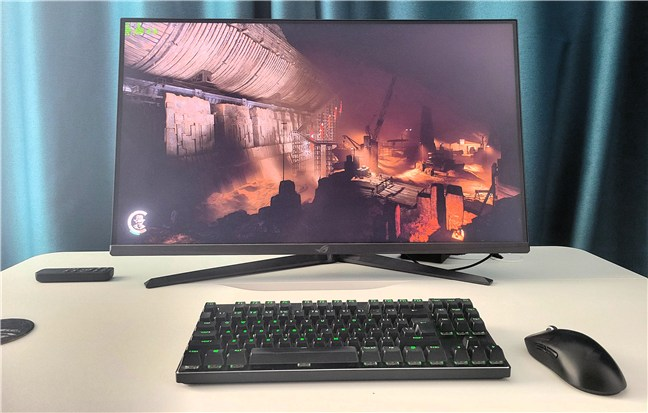

Playing Indiana Jones and the Great Circle
Oh, and I can say that the fans didn’t become annoying even in demanding tasks like the games I mentioned. They produce a constant airflow sound that’s very easy to ignore, because it’s not loud at all. While gaming, the GPU temperature was around 60 – 65°C (140 – 149° F).
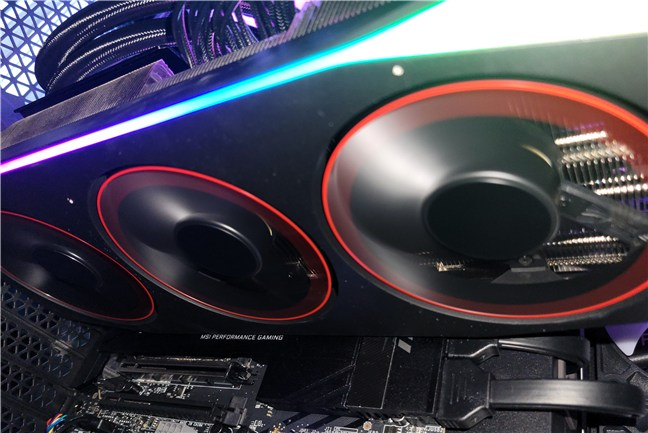

The fans are silent
One of the best surprises was how convenient the magnetic fans are. I took them out a couple of times (with the PC turned off, obviously) to check for dust and immediately put them back in. This process is extraordinarily simple and almost makes cleaning the video card fun. Almost. 🙂
Overall, I’ve had a great experience with the XFX Mercury Radeon RX 9070XT OC. It runs cool, it’s quiet and it handles heavy tasks without drawing attention. As long as you have room in the case and a powerful enough source, this GPU fits perfectly in a high-end system and delivers top performance.
Performance in games and benchmarks
To really understand what the XFX Mercury AMD Radeon RX 9070XT OC Magnetic Air Edition with RGB can do, I tested it in several modern games and synthetic benchmarks. All tests were performed with Ultra graphics settings and ray tracing enabled where available. I disabled the AMD FSR and NVIDIA DLSS technologies to focus on the native rendering performance. I compared the XFX GPU to other similar Radeon models (the ASUS PRIME Radeon RX 9070 XT GAMING OC 16G, the ASRock Radeon RX 9070 Steel Legend and the GIGABYTE Radeon RX 9070 XT GAMING OC 16G), as well as a strong competitor from NVIDIA: the ASUS PRIME GeForce RTX 5070 Ti.
In Cyberpunk 2077, one of the most demanding titles in recent years, the XFX Mercury Mercury Radeon RX 9070XT OC leads the Radeon lineup by a wide margin. In 1440p resolution, it’s nearly 4% faster than the GIGABYTE implementation and 25% faster than ASRock’s Radeon RX 9070. In 4K resolution, it maintains a lead over the other AMD GPUs, but lags about 13% behind the GeForce RTX 5070 Ti.
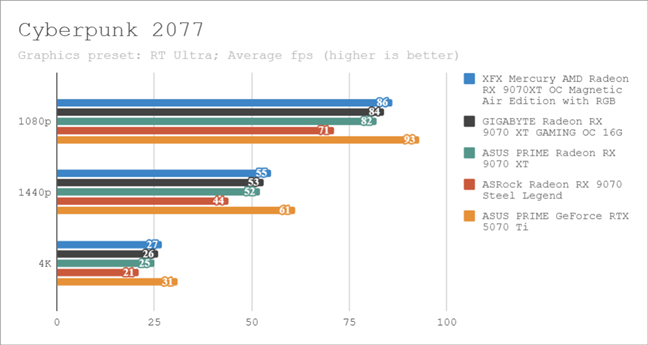

Benchmark results in Cyberpunk 2077
The Callisto Protocol is a horror game where shadows, reflections, and ray tracing add to your immersion. And beyond that, it also contributes to your video card anxiety. 🙂 But XFX manages to pull it off with flying colors, delivering a similar framerate to other cards in the AMD Radeon RX 9070 XT series. In 4K resolution, it even manages to match NVIDIA GeForce RTX 5070 Ti’s performance.
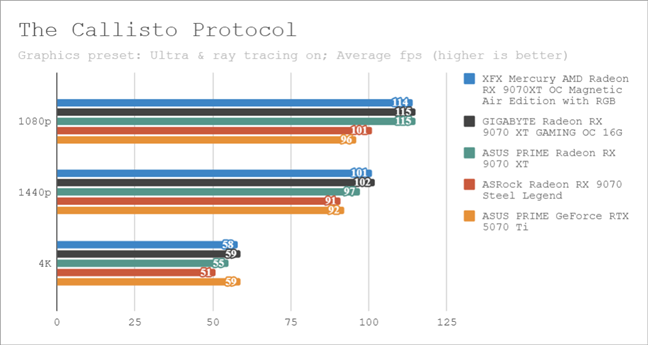

Benchmark results in The Callisto Protocol
In The Witcher 3: Wild Hunt Next-Gen Update, Geralt got a serious visual “facelift,” and the system requirements obviously increased considerably. XFX offers similar performance to GIGABYTE’s and ASUS’ Radeon RX 9070 XT models in all resolutions tested. While NVIDIA’s GeForce RTX 5070 Ti is still faster, the XFX card’s AMD hardware also delivers a smooth and competitive experience.
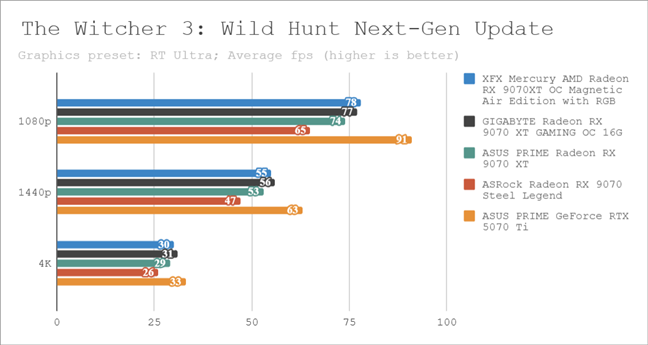

Benchmark results in The Witcher 3 Wild Hunt Next-Gen Update
Total War: WARHAMMER III is a strategy game packed with all types of military units and lots of visual effects, which makes it ideal for testing any graphics card. The good news is that the XFX card performs admirably, being at least as fast as the ASUS or GIGABYTE models based on the same Radeon RX 9070 XT GPU, both in 1440p and 4K resolution. It even outperforms the ASUS PRIME GeForce RTX 5070 Ti.
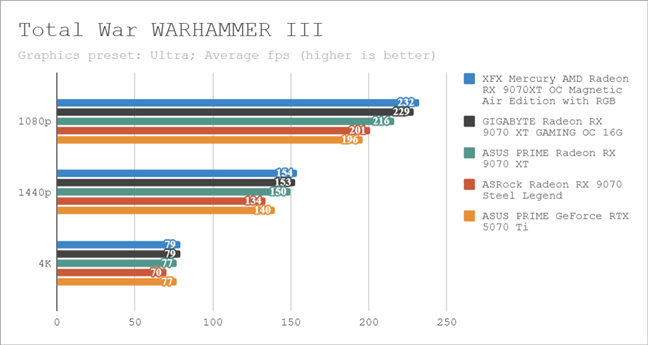

Benchmark results in Total War WARHAMMER III
Rendering the action in Assassin’s Creed Mirage’s recreated Baghdad isn’t terribly difficult for modern video cards. However, it’s a pretty demanding game in high resolutions. At 1440p and 4K resolutions, the XFX Mercury proved to be about as fast as other GIGABYTE or ASUS Radeon RX 9070 XT GPUs. More interestingly, all of them outperformed the NVIDIA GeForce RTX 5070 Ti by up to 7.33% in both 1440p and 4K.
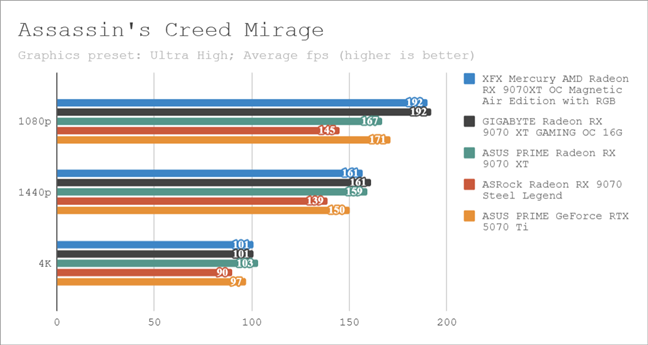

Benchmark results in Assassin’s Creed Mirage
In Resident Evil Village, with active ray tracing, the gothic vibe calls for a serious GPU. The XFX is faster than the bare ASRock Radeon RX 9070 in both 1440p and 4K. Compared to other models based on the same Radeon RX 9070 XT GPU, the differences blur. And compared to the GeForce RTX 5070 Ti, it lags about 7 to 14% behind in 1440p and 4K resolutions. However, the game runs very well on all the tested video cards, so there’s no need to be scared of low frame rates; you’d better watch out for vampires. 🧛
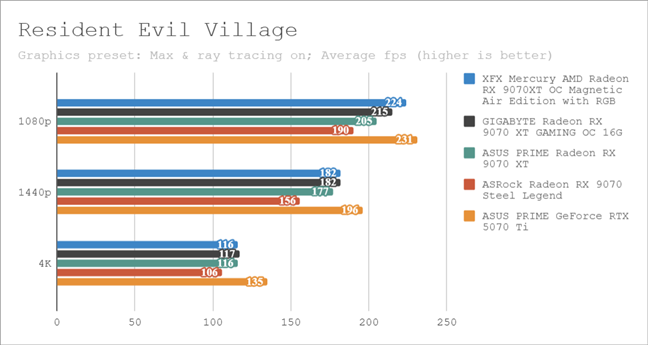

Benchmark results in Resident Evil Village
F1 22 is a title where every frame counts, especially if you want to turn a perfect corner on your new 144Hz (or more!?) fast-refresh monitor. Once again, the XFX Mercury GPU holds its own against the other Radeon RX 9070 XT models. It also performs better than the ASRock Radeon RX 9070 Steel Legend, with differences between 18 and 35%, depending on the resolution used. Looking at the results of the NVIDIA GeForce RTX 5070 Ti GPU, the XFX Mercury AMD Radeon RX 9070XT OC Magnetic Air Edition with RGB matches them in 4K resolution, is within a tiny 1 frame per second in 1440p, and easily outperforms them in 1080p, by over 11%.
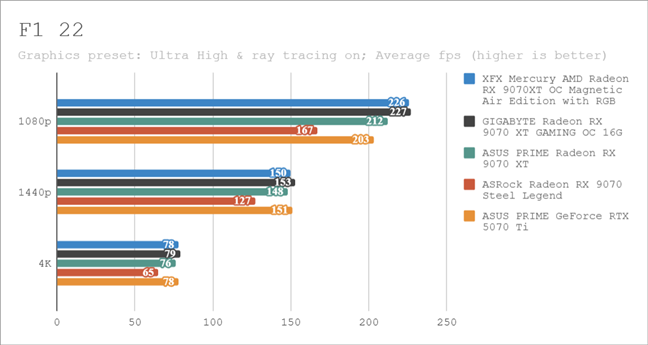

Benchmark results in F1 22
In Starfield, traveling between and on planets is an excellent test for your GPU. The XFX Mercury is slightly faster (by 1-2 frames per second) in 4K resolution than the other Radeon RX 9070 XT models, as well as the GeForce RTX 5070 Ti. In 1440p and 1080p, however, the GIGABYTE model surpasses it quite significantly. And yet, XFX manages to outperform NVIDIA’s competing video card in all the tested resolutions, with differences between 4 and 11%!
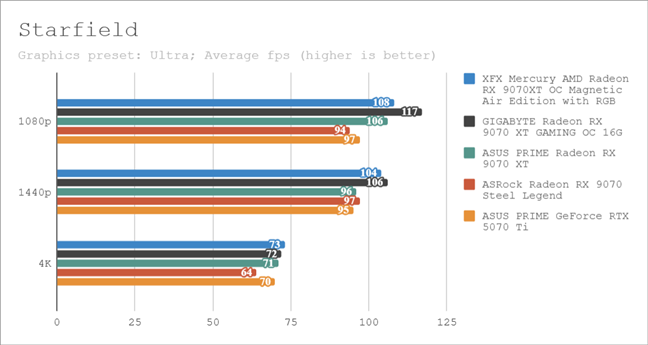

Benchmark results in Starfield
In 3DMark’s synthetic tests, the XFX Mercury AMD Radeon RX 9070XT OC Magnetic Air Edition with RGB confirms in-game results: it’s a high-performance Radeon GPU. In Time Spy Extreme, it outperforms NVIDIA by 6%, and in Port Royal, which simulates ray tracing, it’s just 2.75% behind its GeForce RTX 5070 Ti rival. In Speed Way, it manages to be on par with the other Radeon RX 9070 XT models, and while it outperforms the (plain) Radeon RX 9070 by almost 12%, the NVIDIA GPU surpasses it by over 21%. In conclusion, it seems to be clear that in rasterization, the classic XFX Mercury AMD Radeon RX 9070XT OC Magnetic Air Edition with RGB excels, but in pure ray tracing, NVIDIA still has the edge.
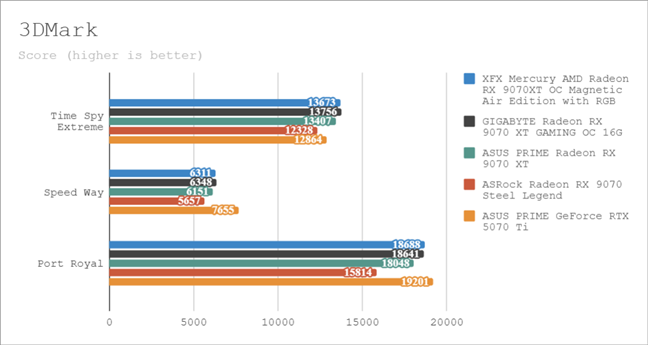

Benchmark results in 3DMark
Under extreme load, the XFX Mercury GPU reaches a maximum temperature of 62°C, which is cooler than the GIGABYTE and the ASUS PRIME, but 2°C warmer than the ASRock. Compared to the GeForce RTX 5070 Ti, which reaches 73°C, the XFX is 15% more thermally efficient. The Magnetic Air system obviously works really well!
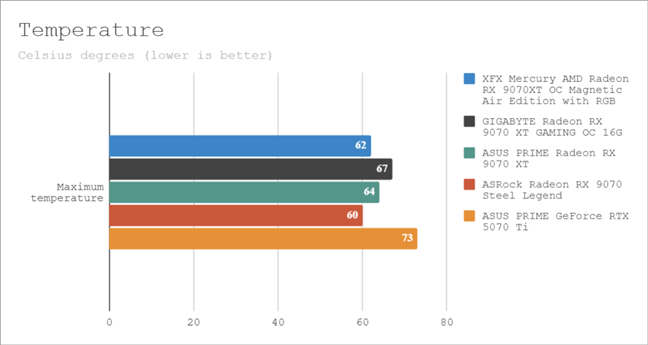

The maximum temperatures reached by the GPUs
When it comes to power consumption, the XFX is the most power-hungry of all the tested GPUs, peaking at 340W, almost 8% more than the ASUS PRIME Radeon RX 9070 XT and 13% more than the GeForce RTX 5070 Ti. This high power consumption is due to the high overclocked boost clocks and requires a power supply to match, with at least 800 watts.
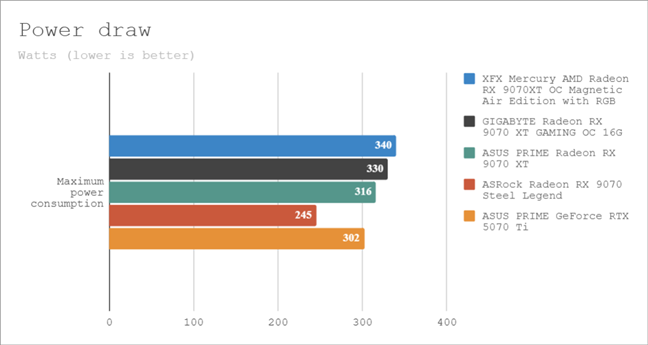

The maximum power consumption
The XFX Mercury AMD Radeon RX 9070XT OC Magnetic Air Edition with RGB is without a doubt one of the most balanced implementations of the Radeon RX 9070 XT GPU. It’s consistently at the top of the Radeon cards in the same range, delivering excellent performance in both 1440p and 4K resolutions. In many cases, it approaches or even surpasses the competing NVIDIA GeForce RTX 5070 Ti. The cooling system is efficient and quiet, and the only downside is the high power consumption. This, however, can be looked upon as an issue only during the brief periods of time when the GPU reaches its maximum clock speed.
What do you think about the XFX Mercury AMD Radeon RX 9070XT OC Magnetic Air Edition with RGB?
I enjoyed testing this GPU, because it showed me what the Radeon RX 9070 XT can do when implemented in a board with custom cooling and an original idea: magnetic fans. It’s not a card for everyone: it’s big, power-hungry, and expensive. But if you have a capable system, a generous budget, and you want a good experience in 1440p or 4K resolutions, the XFX Mercury gives you just that. Now, I’m curious: what do you think of this video card? Did you try it or are you considering it for your next upgrade? Or maybe you have another recommendation in the same performance segment? Leave a comment and tell me what you think.
Source link





